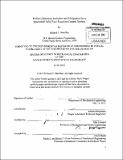| dc.contributor.advisor | Edward Bergmann and John Leonard. | en_US |
| dc.contributor.author | Shreffler, Richard C. (Richard Charles) | en_US |
| dc.contributor.other | Massachusetts Institute of Technology. Dept. of Mechanical Engineering. | en_US |
| dc.date.accessioned | 2012-11-19T19:32:47Z | |
| dc.date.available | 2012-11-19T19:32:47Z | |
| dc.date.copyright | 2012 | en_US |
| dc.date.issued | 2012 | en_US |
| dc.identifier.uri | http://hdl.handle.net/1721.1/74990 | |
| dc.description | Thesis (S.M.)--Massachusetts Institute of Technology, Dept. of Mechanical Engineering, 2012. | en_US |
| dc.description | Cataloged from PDF version of thesis. | en_US |
| dc.description | Includes bibliographical references (p. 84-85). | en_US |
| dc.description.abstract | Future unmanned space missions will require increased redundancy to failure. One such mission is the Mars Sample Return, intended to return a sample of Martian soil, rock and atmosphere to Earth for greater study. A key element of the Mars Sample Return mission is the Mars Ascent Vehicle, which is designed to carry the sample container from the surface into Mars orbit, where the sample will be transferred to the Earth return vehicle. The Mars Ascent Vehicle is currently proposed as a two-stage solid fuel vehicle, which is ideal for surviving the long interplanetary journey and environmental extremes of the Martian surface. This thesis details real time failure detection, isolation and mitigation algorithms for use with a six degree of freedom solid fuel reaction control system, which commonly functions by burning a solid fuel gas generator and expelling gas out of valves arranged around the vehicle. Valve failures are known to occur in spacecraft reaction control systems, and without on-board, real time failure identification and mitigation, the Mars Ascent Vehicle could fail to place the sample container in the proper orbit. The two failure modes which are considered here are valves firing continuously, an on failure, or a valve not firing when commanded, an off failure. The detection and isolation algorithm relies on comparing the expected with the actual change in vehicle angular and linear rates in order to determine the disturbance acceleration that has been applied to the vehicle. For an on failure, the mitigation algorithm works by commanding on the jet which directly opposes the failed jet, and for an off failure, the failed jet is simply removed from the available jets to be commanded. The algorithms detailed here provide increased redundancy to failure and greater robustness without the need for additional dedicated detection hardware and at minimal computing load. These algorithms could also be adapted to other space vehicles and numerous other applications. | en_US |
| dc.description.statementofresponsibility | by Richard C. Shreffler. | en_US |
| dc.format.extent | 85 p. | en_US |
| dc.language.iso | eng | en_US |
| dc.publisher | Massachusetts Institute of Technology | en_US |
| dc.rights | M.I.T. theses are protected by
copyright. They may be viewed from this source for any purpose, but
reproduction or distribution in any format is prohibited without written
permission. See provided URL for inquiries about permission. | en_US |
| dc.rights.uri | http://dspace.mit.edu/handle/1721.1/7582 | en_US |
| dc.subject | Mechanical Engineering. | en_US |
| dc.title | Failure detection, isolation and mitigation for a spacecraft solid fuel reaction control system | en_US |
| dc.type | Thesis | en_US |
| dc.description.degree | S.M. | en_US |
| dc.contributor.department | Massachusetts Institute of Technology. Department of Mechanical Engineering | |
| dc.identifier.oclc | 815966586 | en_US |
